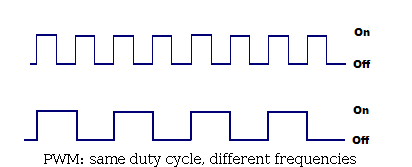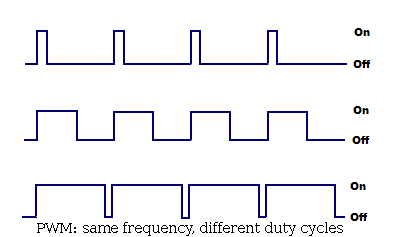PWM Intro - Pulse Width Modulation
In the following tutorials, we're going to (try to) have some fun with PWM. PWM stands for Pulse Width Modulation, and is quite weird when you first face this (this was at least my first feeling). So here's a brief explanation of what it is about.
How does PWM look like ?...
PWM is about
switching one pin (or more) high and low, at different frequencies and
duty cycles. This is a on/off process. You can either vary:
- the frequency,
- or the duty cycle, that is the proportion where the pin will be high
Figure 1. PWM: same duty cycle, different frequencies.


Both have a 50% duty cycle (50% on, 50% off), but the upper one's frequency is twice the bottom
Figure 2. PWM: same frequency, different duty cycles


Three different duty cycle (10%, 50% and 90%), all at the same frequency
But what is PWM for ? What can we do with it ? Many things,
like:
- producing variable voltage (to control DC motor speed, for instance)
- playing sounds: duty cycle is constant, frequency is variable
- playing PCM wave file (PCM is Pulse Code Modulation)
- ...
That said, we're now goind to experiment these two major properties.
Parent topic: PIC internals